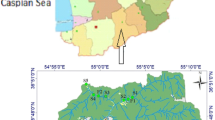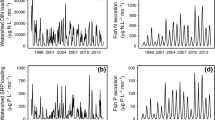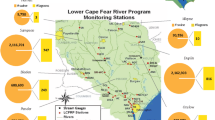Abstract
Excess nitrogen is a forceful agent of ecological change in coastal waters, and wastewater is a prominent source of nitrogen. In catchments where multiple sources of nitrogen pollution co-exist, biological indicators are needed to gauge the degree to which wastewater-N can propagate through the receiving food webs. The purpose of this study was to test whether estuarine fish are suitable as indicators of sewage-N pollution. Fish were analysed from three estuaries within a 100-km strip on the Australian East Coast. The estuaries differ substantially in wastewater loading: (1) the Maroochy Estuary receives a large fraction of the local shire’s treated sewage, (2) the Mooloolah Estuary has no licensed treated wastewater outfalls but marinas/harbours and stormwater may contribute nitrogen, and (3) the Noosa Estuary which neither receives licensed discharges nor has suspected wastewater loads. Sampling for fish included both high rainfall (‘wet’ season) and low rainfall (‘dry’ season) periods. Muscle-δ15N was the variable predicted to respond to treated wastewater loading, reflecting the relative enrichment in 15N resulting from the treatment process and distinguishing it from alternative N sources such as fertiliser and natural nitrogen inputs (both 15N-depleted). Of the 19 fish species occurring in all three estuaries, those from the Maroochy Estuary had significantly elevated δ15N values (up to 9.9‰), and inter-estuarine differences in fish-δ15N were consistent across seasons. Furthermore, not only did all fish from the estuary receiving treated wastewater carry a very distinctive sewage-N tissue signal, but enriched muscle-δ15N was also evident in all species sampled from the one estuary in which sewage contamination was previously only suspected (i.e. the Mooloolah Estuary: 0.2–4.8‰ enrichment over fish from reference system). Thus, fish-δ15N is a suitable indicator of wastewater-N not only in systems that receive large loads, but also for the detection of more subtle nitrogen inputs. Arguably, fish may be preferred indicators of sewage-N contamination because they: (1) integrate nitrogen inputs over long time periods, (2) have an element of ‘ecological relevance’ because fish muscle-δ15N reflect movement of sewage-N through the food chain, and (3) pollution assessments can usually be based on evidence from multiple species.








Similar content being viewed by others
References
Anderson DM, Gilbert PM, Burkholder JM (2002) Harmful algal blooms and eutrophication: nutrient sources, composition, and consequences. Estuaries 25:704–726
Archambault P, Banwell K, Underwood AJ (2001) Temporal variation in the structure of intertidal assemblages following the removal of sewage. Mar Ecol Prog Ser 222:51–62
Beling E, McAllister A (2004) Maroochy Estuary sustainable loads study. WBM-Oceanics, Brisbane
Cabana G, Rasmussen JB (1996) Comparison of aquatic food chains using nitrogen isotopes. Proc Natl Acad Sci USA 93:10844–10847
Cifuentes LA, Coffin RB, Solorzano L, Cardenas W, Espinoza J, Twillet RR (1996) Isotopic and elemental variations of carbon and nitrogen in a mangrove estuary. Est Coast Shelf Sci 43:781–800
Clesceri LS, Greenberg AE, Eaton AD (1998) Standard methods for the examination of water and wastewater, 20th edn. American Public Health Association, Baltimore
Cole ML, Valiela I, Kroeger KD, Tomasky GL, Cebrian J, Wigand C, McKinney RA, Grady SP, da Silva MHC (2004) Assessment of a delta N-15 isotopic method to indicate anthropogenic eutrophication in aquatic ecosystems. J Environ Qual 33:124–132
Costanzo SD, O’ Donohue MJ, Dennison WC, Loneragan NR, Thomas M (2001) A new approach for detecting and mapping sewage impacts. Mar Pollut Bull 42:149–156
deBruyn AMH, Rasmussen JB (2002) Quantifying assimilation of sewage-derived organic matter by riverine benthos. Ecol Appl 12:511–520
deBruyn AMH, Marcogliese DJ, Rasmussen JB (2002) Altered body size distributions in a large river fish community enriched by sewage. Can J Fish Aquat Sci 59:819–828
deBruyn AMH, Marcogliese DJ, Rasmussen JB (2003) The role of sewage in a large river food web. Can J Fish Aquat Sci 60:1332–1344
van Dover CL, Grassle JF, Fry B, Garritt RH, Starczak VR (1992) Stable isotope evidence for entry of sewage-derived organic material into a deep-sea food web. Nature 360:153–156
Field EJ (1987) Aspects of distribution, movements and growth of juvenile mullets (Mugilidae) inhabiting a small estuary in south-east Queensland, Australia. PhD Thesis. University of Queensland, Brisbane
Gagné F, Blaise C (2003) Biomarkers to assess endocrine disruption of reproduction in bivalves. In: Mothersill C, Austin B (eds) In vitro methods in aquatic toxicology. Springer, Berlin Heidelberg New York, pp 221–240
Gaston TF, Suthers IM (2004) Spatial variation in δ13C and δ15N of liver, muscle and bone in a rocky reef planktivorous fish: the relative contribution of sewage. J Exp Mar Biol Ecol 304:17–33
Gaston TF, Kostoglidis A, Suthers IM (2004) The 13C, 15N and 34S signatures of a rocky reef planktivorous fish species indicate different coastal discharge of sewage. Mar Freshw Res 55:1–11
Griffin MPA, Valiela I (2001) δ15N isotope studies of life history and trophic position of Fundulus heteroclitus and Menidia menidia. Mar Ecol Prog Ser 214:299–305
Hansson S, Hobbie JE, Elmgren R, Larsson U, Fry B, Johansson S (1997) The stable nitrogen isotope ratio as a marker of food-web interactions and fish migration. Ecology 78:2249–2257
Heaton THE (1986) Isotopic studies of nitrogen pollution in the hydrosphere and atmosphere: a review. Chem Geol 59:87–102
Hesslein RH, Hallard KA, Ramlal P (1993) Replacement of sulphur, carbon, and nitrogen tissue of growing broad whitefish (Coregonus nasus) in response to a change in diet traced by δ34S, δ13C, and δ15N. Can J Fish Aquat Sci 50:2071–2076
Hindell JS, Quinn GP (2000) Effects of sewage effluent on the population structure of Brachidontes rostratus (Mytilidae) on a temperate intertidal rocky shore. Mar Freshw Res 51:543–551
Jennings S, Reñones O, Morales-Nin B, Polunin NVC, Moranta J, Coll J (1997) Spatial variation in the 15N and 13C stable isotope composition of plants, invertebrates and fishes on Mediterranean reefs: implications for the study of trophic pathways. Mar Ecol Prog Ser 146:109–116
Jobling S, Tyler CR (2003) Endocrine disruption, parasites and pollutants in wild freshwater fish. Parasitology 126:S103-S108
Jones A, Schlacher TA (2002) Noosa River. In: Abal EG, Moore KB, Gibbes BR, Dennison WC (eds) State of the south-east Queensland waterways report 2001. Moreton Bay Waterways and Catchments Partnership, Brisbane, pp 5–10
Kendall C (1998) Tracing nitrogen sources and cycling in catchments. In: Kendall C, McDonnell JJ (eds) Isotope tracers in catchment hydrology. Elsevier, Amsterdam, pp 519–576
Kendall C, Silva SR, Kelly VJ (2001) Carbon and nitrogen isotopic compositions of particulate organic matter in four large river systems across the United States. Hydrol Proc 15:1301–1346
Kennish MJ (1990) Ecology of estuaries, vol II: biological aspects. CRC Press, Florida
Kerby BM, Brown IW (1994) Bream, whiting and flathead in south-east Queensland: a review of the literature. Department of Primary Industries, Brisbane
Lake JL, McKinney RA, Osterman FA, Pruell RJ, Kiddon J, Ryba SA, Libby AD (2001) Stable nitrogen isotopes as indicators of anthropogenic activities in small freshwater systems. Can J Fish Aquat Sci 58:870–878
McClelland JW, Valiela I (1998a) Changes in food web structure under the influence of increased anthropogenic nitrogen inputs to estuaries. Mar Ecol Prog Ser 168:259–268
McClelland JW, Valiela I (1998b) Linking nitrogen in estuarine producers to land-derived sources. Limnol Oceanogr 43:577–585
McClelland JW, Valiela I, Michener RH (1997) Nitrogen-stable isotope signatures in estuarine food webs—a record of increasing urbanization in coastal watersheds. Limnol Oceanogr 42:930–937
McKinney RA, Lake JL, Charpentier MA, Ryba S (2002) Using mussel isotope ratios to assess anthropogenic nitrogen inputs to freshwater ecosystems. Environ Monit Assess 74:167–192
Meng L, Gray C, Taplin B, Kupcha E (2000) Using winter flounder growth rates to assess habitat quality in Rhode Island’s coastal lagoons. Mar Ecol Prog Ser 201:287–299
Meng L, Powell JC, Taplin B (2001) Using winter flounder growth rates to assess habitat quality across an anthropogenic gradient in Narragansett Bay, Rhode Island. Estuaries 24:576–584
Moore MJ, Mitrofanov IV, Valentini SS, Volkov VV, Kurbskiy AV, Zhimbey EN, Eglinton LB, Stegeman JJ (2003) Cytochrome P4501A expression, chemical contaminants and histopathology in roach, goby and sturgeon and chemical contaminants in sediments from the Caspian Sea, Lake Balkhash and the Ily River Delta, Kazakhstan. Mar Pollut Bull 46:107–119
Morris L, Keough MJ (2002) Organic pollution and its effects: a short-term transplant experiment to assess the ability of biological endpoints to detect change in a soft sediment environment. Mar Ecol Prog Ser 225:109–121
Nixon SW, Buckley BA (2002) “A strikingly rich zone”—nutrient enrichment and secondary production in coastal marine ecosystems. Estuaries 25:782–796
Pantsar-Kallio M, Mujunen SP, Hatzimihalis G, Koutoufides P, Minkkinen P, Wilkie PJ, Connor MA (1999) Multivariate data analysis of key pollutants in sewage samples: a case study. Anal Chim Acta 393:181–191
Parsons TR, Maita Y, Lalli CM (1984) A manual of chemical and biological methods for seawater analysis. Pergamon, Oxford
Peierls BL, Caraco NF, Pace ML, Cole JJ (1991) Human influence on river nitrogen. Nature 350:386–387
Pollock BR (1984) Relations between migration, reproduction and nutrition in yellowfin bream Acanthopagrus australis (Gunther). Mar Ecol Prog Ser 19:17–23
Rau GH, Sweeney RE, Kaplan IR, Mearns AJ, Young DR (1981) Differences in animal 13C, 15N and D abundances between a polluted and an unpolluted coastal site: likely indicators of sewage uptake by a marine food web. Est Coast Shelf Sci 13:701–707
Rogers K (2003) Stable carbon and nitrogen isotope signatures indicate recovery of marine biota from sewage pollution at Moa Point, New Zealand. Mar Pollut Bull 46:821–827
Schlacher TA, Caruthers T (2002a) Maroochy River. In: Abal EG, Moore KB, Gibbes BR, Dennison WC (eds) State of the south-east Queensland waterways report 2001. Moreton Bay Waterways and Catchments Partnership, Brisbane, pp 11–17
Schlacher TA, Caruthers T (2002b) Mooloolah River. In: Abal EG, Moore KB, Gibbes BR, Dennison WC (eds) State of the south-east Queensland waterways report 2001. Moreton Bay Waterways and Catchments Partnership, Brisbane, pp 18–25
Schlacher TA, Wooldridge TH (1996) Origin and trophic impotance of detritus—evidence from stable isotopes in the benthos of a small, temperate estuary. Oecologia 106:382–388
Schlacher TA, Carruthers T, Dennison WC, Pocock J, Katouli M (2001) Maroochy Mooloolah loads and impacts study. WBM-Oceanics, Brisbane
Sheaves MJ (1993) Patterns of movement of some fishes within an estuary in tropical Australia. Aust J Mar Freshw Res 44:867–880
Spies RB, Kruger H, Ireland R, Rice DW Jr (1989) Stable isotope ratios and contaminant concentrations in a sewage-distorted food web. Mar Ecol Prog Ser 54:157–170
Steffy LY, Kilham SS (2004) Elevated δ15N in stream biota in areas with septic tank systems in an urban watershed. Ecol Appl 14:637–641
Thomas CJ, Cahoon LB (1993) Stable isotope analyses differentiate between different trophic pathways supporting rocky-reef fishes. Mar Ecol Prog Ser 95:19–24
Turner RE, Rabalais NN, Justic D, Dortch Q (2003) Global patterns of dissolved N, P and Si in large rivers. Biogeochemistry 64:297–317
Urbain V, Wright P, Thomas M (2001) Performance of the full-scale biological nutrient removal plant at Noosa in Queensland, Australia: nutrient removal and disinfection. Water Sci Technol 44:57–62
Valiela I, Collins G, Kremer J, Lajtha K, Geist M, Seely B, Brawley J, Sham CH (1997) Nitrogen loadings from coastal watersheds to receiving estuaries: new method and application. Ecol Appl 7:358–380
Valiela I, Geist M, McClelland J, Tomasky G (2000) Nitrogen loading from watersheds to estuaries: verification of the Waquoit Bay nitrogen loading model. Biogeochemistry 49:277–293
Wainright SC, Fuller CM, Michener RH, Richards RA (1996) Spatial variation of trophic position and growth rate of juvenile striped bass (Morone saxatilis) in the Delaware River. Can J Fish Aquat Sci 53:685–692
Acknowledgements
This project was funded by the Moreton Bay Waterways and Catchments Partnership and carried out under the University of the Sunshine Coast’s Animal Care and Ethics Approval# AN/A/01/10R.
Author information
Authors and Affiliations
Corresponding author
Additional information
Communicated by Jim Ehleringer
Rights and permissions
About this article
Cite this article
Schlacher, T.A., Liddell, B., Gaston, T.F. et al. Fish track wastewater pollution to estuaries. Oecologia 144, 570–584 (2005). https://doi.org/10.1007/s00442-005-0041-4
Received:
Accepted:
Published:
Issue Date:
DOI: https://doi.org/10.1007/s00442-005-0041-4




